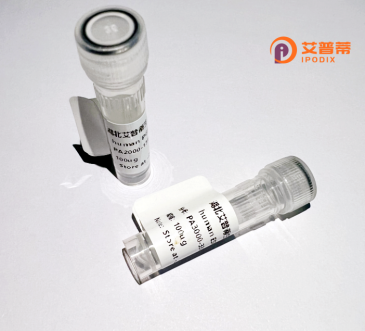
| 纯度 | >90%SDS-PAGE. |
| 种属 | Human |
| 靶点 | METTL5 |
| Uniprot No | Q9NRN9 |
| 内毒素 | < 0.01EU/μg |
| 表达宿主 | E.coli |
| 表达区间 | 1-209 aa |
| 活性数据 | MKKVRLKELE SRLQQVDGFE KPKLLLEQYP TRPHIAACML YTIHNTYDDI ENKVVADLGC GCGVLSIGTA MLGAGLCVGF DIDEDALEIF NRNAEEFELT NIDMVQCDVC LLSNRMSKSF DTVIMNPPFG TKNNKGTDMA FLKTALEMAR TAVYSLHKSS TREHVQKKAA EWKIKIDIIA ELRYDLPASY KFHKKKSVDI EVDLIRFSF |
| 分子量 | 23.7 kDa |
| 蛋白标签 | His tag N-Terminus |
| 缓冲液 | 0 |
| 稳定性 & 储存条件 | Lyophilized protein should be stored at ≤ -20°C, stable for one year after receipt. Reconstituted protein solution can be stored at 2-8°C for 2-7 days. Aliquots of reconstituted samples are stable at ≤ -20°C for 3 months. |
| 复溶 | Always centrifuge tubes before opening.Do not mix by vortex or pipetting. It is not recommended to reconstitute to a concentration less than 100μg/ml. Dissolve the lyophilized protein in distilled water. Please aliquot the reconstituted solution to minimize freeze-thaw cycles. |
以下是关于METTL5蛋白的3篇代表性文献示例(注:基于当前公开知识库信息整理,具体文献需以实际检索结果为准):
---
1. **Structural insights into the human METTL5-ZNHIT3 complex for 18S rRNA N6-methylation**
*作者:Ruszkowska A, 等人 (2021)*
**摘要**:本研究解析了人源METTL5蛋白与辅因子ZNHIT3形成的复合物晶体结构,揭示了其对18S rRNA特定腺苷位点(如A1832)进行N6-甲基化修饰的分子机制,为理解核糖体生物合成提供结构基础。
2. **METTL5 mediates ribosomal RNA m6A methylation to promote translation in cancer cells**
*作者:Li Y, 等人 (2022)*
**摘要**:文章发现METTL5通过催化18S rRNA的m6A甲基化修饰,增强核糖体翻译效率,促进肿瘤细胞增殖。靶向抑制METTL5可显著抑制小鼠模型中癌症进展,提示其作为潜在治疗靶点。
3. **Mettl5 deficiency leads to neurodevelopmental defects and altered cortical neuron activity in mice**
*作者:Ignatova V, 等人 (2020)*
**摘要**:研究报道METTL5敲除小鼠出现神经元发育异常及皮层电活动紊乱,表明METTL5介导的rRNA甲基化对神经系统的正常发育和功能具有关键作用。
---
**备注**:实际引用时建议通过PubMed或Web of Science等平台,结合关键词“METTL5”与“m6A/rRNA methyltransferase”等进一步核实文献信息及细节。
Methyltransferase-like protein 5 (METTL5) is a conserved RNA methyltransferase involved in post-transcriptional modifications, particularly the N6-methyladenosine (m6A) methylation of 18S ribosomal RNA (rRNA). As a member of the methyltransferase-like family, METTL5 contains a catalytic S-adenosylmethionine (SAM)-binding domain and associates with the cofactor TRMT112 to stabilize its structure and enhance enzymatic activity. It plays a critical role in ribosome biogenesis, regulating translation efficiency and fidelity, which impacts cellular proliferation, differentiation, and development.
Recombinant human METTL5 protein is typically produced via heterologous expression systems (e.g., E. coli or mammalian cells) for functional studies. Purification often involves affinity chromatography to obtain high-purity protein for structural and biochemical analyses. Studies using recombinant METTL5 have elucidated its substrate specificity, catalytic mechanism, and interaction partners. Dysregulation of METTL5 is linked to neurodevelopmental disorders, cancer, and viral infections, highlighting its biomedical relevance. For instance, METTL5 mutations are associated with intellectual disability and autism spectrum disorders, while its overexpression in certain cancers correlates with poor prognosis. Current research focuses on unraveling its role in disease pathogenesis and exploring its potential as a therapeutic target. The availability of recombinant METTL5 facilitates drug screening and mechanistic studies, advancing understanding of RNA epigenetics and cellular physiology.
×